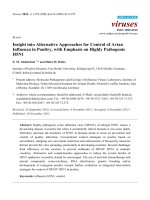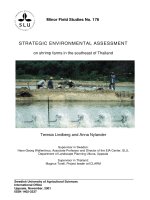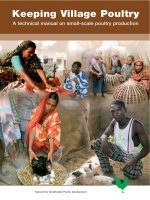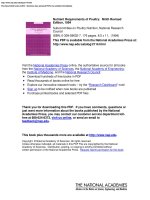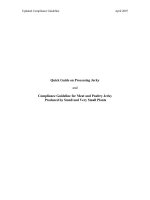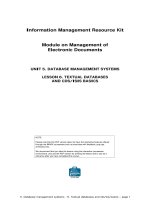Technical Guide on Post-harvest of Banana doc
Bạn đang xem bản rút gọn của tài liệu. Xem và tải ngay bản đầy đủ của tài liệu tại đây (729.93 KB, 8 trang )
Technical Guide
on Post-harvest of Banana
(Musa paradisiaca var. sapientum)
Use of Refrigeration and
Ethylene Generator Equipment
TCP/ERI/3002
Prepared and revised by
Dr. Fabio Mencarelli
Post-harvest Expert
University La Tuscia, Viterbo, Italy
and
Danilo J. Mejía L. Ph.D
AGST-Officer, FAO
ERITREAN
MINISTRY
OF
AGRICULTURE
Food and
Agricultural
Organization FAO
of the United
Nations
Rome, 2004
bananas.qxd 17-12-2004 13:23 Pagina A
Contents
A. Introduction . . . . . . . . . . . . . . . . . . . . . . . . . . . . . . . . . . . . . . . 2
B. Banana Grow and Some Pre-harvest Considerations . . . . . . . 2
C. Quality Standards . . . . . . . . . . . . . . . . . . . . . . . . . . . . . . . . . . . 3
D. Harvest Index . . . . . . . . . . . . . . . . . . . . . . . . . . . . . . . . . . . . . . 5
E. Harvest Care . . . . . . . . . . . . . . . . . . . . . . . . . . . . . . . . . . . . . . . 5
F. Transport to the Packing Shed . . . . . . . . . . . . . . . . . . . . . . . . . 6
G. Packing Shed Operations . . . . . . . . . . . . . . . . . . . . . . . . . . . . . 6
H. Storage and Stacking . . . . . . . . . . . . . . . . . . . . . . . . . . . . . . . . . 7
I. Cold Room Instructions . . . . . . . . . . . . . . . . . . . . . . . . . . . . . . 9
J. Maintenance . . . . . . . . . . . . . . . . . . . . . . . . . . . . . . . . . . . . . . . 10
K. Troubleshooting . . . . . . . . . . . . . . . . . . . . . . . . . . . . . . . . . . . . 10
L. Banana Ripening Requirements . . . . . . . . . . . . . . . . . . . . . . . . 12
M. Ethylene generator operation steps . . . . . . . . . . . . . . . . . . . . . . 14
A. Introduction
Eritrea was in the past an exporter of fruit and vegetables to the Middle East and Europe, with
bananas being a significant component of its exports. However, banana exports ceased after 1974
as banana plantations decreased due to problems associated with war. Current banana
production is based on a total area of about 1 500 ha., mostly in Akordet and Tesseney, areas of
the Gash-Barka region, where FAO through its technical cooperation programme implemented,
in several phases, a project initially titled: “Preliminary Assistance for Launching Banana
Production, Quality and Export Improvement Programme” and later as “Horticultural
Marketing Development”. The main objectives of these projects have been addressed to
strengthen the most relevant post-harvest technologies associated to the improvement of quality
and safety of national crop production and its commercialization with emphasis for banana and
onion. Therefore, the Agriculture Support System Division of FAO through its technical units
AGST and AGSF as lead technical units, along with the Ministry of Agriculture of Eritrea have
carried out different activities in order to achieve the objectives approached in these projects.
This brochure is a partial result of different activities undertaken in Eritrea to reinforce the post-
harvest sector. It is more focused on those technical activities related to the handling, packaging,
ripening and storage of banana.
B. Banana Growing and Pre-harvest Considerations
Banana can grow in many types of soil and it is specially productive in deep soil with loam or
clay loam textures; it can thrive at an elevation of 1.5 to 1 000 m above sea level and produces
sweeter fruits at 600 m and above. The density of planting can be from 1 500-2 000
plants/hectare and it is harvested 11 to 13 months after planting and then, every 9 months can
produce bunches in good growing condition. It tolerates wide soil pH, but 6.5 should be idealy.
It requires organic matter to be not less than 2.5 percent (300-600 kg/h/year of ammonium
sulphate or ammonium nitrate), 24 ppm of phosphorus, 400-600 ppm of potassium and
calcium, magnesium and sulphur to grows well, as well as, some micronutrients, mainly boron,
manganese and zinc. Banana also grow well in areas with a rainfall of 7 mm/day or 25-50 mm
per week and needs well drained soils. It does not grow well in wet or flooded areas. Banana can
tolerate a wind speed of 10 to14 km/hr but above 35 km/hr may reduce production due to leaf
shredding.
The harvest maturity of banana fruits may be based on the following indices: a) the angularity
or shape of the fingers. It is recommended that banana should be harvested when the fruit shape
is full
3
/4 or full stage depending on the selected market. b) the physiological age of the fruit
based on the number of weeks from shooting (when the flower bud appears) to maturity.
Harvesting the bunches is preferable in the morning. Cut the trunk slowly about one third from
the top for the bunch to fall slowly. Hold the tail end of the bunch before it touches the ground.
Then cut the peduncle, leaving about 30 cm of the stalk for easy handling.
C. Quality Standards
Quality Standards (EU Standards).These standards refer to genus Musa (AAA) Spp, subgroup
Cavendish e Gross Michel.
Quality characteristics
1. The minimum characteristics of bananas requested before ripening for all the categories
must be:
• green but with an adequate development stage, and not ripened; whole firm; sound; clean; free
from parasites; free from decay symptoms; with intact, sound, clean stem; free of flowers
residues; free of deformation and normally curved; free of any external leakage; no off-odors
and off-flavors
2. Classification.
Bananas are classified in three categories:
i) Extra. Bananas must not have any defects, except slight peel defects (less than 1 cm
2
over all
surface) which do not affect the appearance of the whole hand, or finger.
ii) First. As before but bananas can present: slight shape defects; slight peel alterations (less than
2 cm2) which have not touched the pulp
iii) Second. Banana must respect the minimum requirements but can present: shape defects; peel
defects due to abrasions (less than 4 cm
2
) which have not touched the pulp.
2 3
bananas.qxd 17-12-2004 13:23 Pagina 2
Calibration (see Figure 1)
To take the following measurements (calliper grade or calibration) we must consider the middle
finger (banana) on outer whorls of the second hand on the stem before running fruit through
packing plant processes.
• banana length: measured (cm) from the base of the banana stem to the apex
• banana width (calliper grade): cross section in the middle of banana (mm)
Calliper grade: ≥ 27 mm. Length: ≥ 14 cm.
Dole Company considers acceptable to good bananas (Dole Class one, Giant Cavendish) with:
calliper grade: 31-39.5 mm (North Europe Markets); 32-38 mm (Mediterranean Markets) and
length: ≥ 19 cm
Tolerances
In each packing case are admitted tolerances in
quality and size.
1.Quality tolerances
i) Category Extra: 5 percent of weight or
number of bananas of first category
ii) First category: 10 percent of weight or
number of bananas not matching
neither the category requirements nor
the minimum requirements, but not
admitted fruits with decay or other
consume intolerable defects.
2.Calibration tolerances
For all the categories, 10 percent of number of
bananas with length less than 1 cm of the
minimum requested (14 cm)
Packing and display
1. Uniformity
Each packing must have only bananas with the same origin, quality, and variety. The visible part
of the bananas inside the box must represent the whole bunch of bananas of the box.
2. Handling
The bananas must be handled in such way to guarantee the product protection. The materials
which are used for packing must be new, clean, and not toxic or physically dangerous for the
product as well as for the consumer. The use of paper or printed materials in contact with the
fruits must be approved for food use. The package must not have any foreign bodies.
3. Display
The bananas must be inside the package in hands or cluster which is minimum 4 fingers
(bananas) together. In each package, one cluster is tolerated without 2 fruits if they are removed
in a correct way, which means with sharp knife cut of the stem. In each layer of the package, it
is admitted only one cluster with 3 bananas with the same characteristics of the other fruits. Dole
Company tolerates clusters with 4-8 bananas but only one cluster with 3 bananas for each box.
14-18 clusters per package are admitted for bananas long more than 19 cm.
External notes in the package
Each package must be shown on the same side clear, readable, and not erasable following
information:
• identification; product type (“banana”, variety name); product origin; commercial
characteristics ( category, net weight, min and max calliper grade and length)
D. Harvest Index
One very useful criteria for harvesting fruit that is used commercially is age of the bunch after
emergence from the pseudo stem (emergence can be defined as the day on which the first
complete hand of fruit is visible).
Important: a) mark with colour straps the banana stems (bunches) according to weeks of age; b)
protect each hand from the other by using plastic film, paper, or other soft, not abrasive,
materials such as leaves (Figure 2) (At a given age, the maturity of hands in a stem varies, those
hands at the proximal end of the stem being more mature than those at the distal end); c)
estimate maturity of the entire stem using the second hand from the proximal end and measuring
length and calliper grade.
E. Harvest Care
• Before cutting the stem PROTECT the whole
bunch with plastic bag to avoid the latex
dropping
• One worker must push up the bunch and
another worker cut the stem with the knife
(machete)
• The third worker carries the whole bunch on
the shoulder having care to use a soft blanket,
not abrasive
• AVOID the contact of the latex with bananas
peel; aluminium sulphate (Alum) is the best to
flocculate latex but if it is not available you can
just dry with paper or other fabric tissue
• DO NOT USE blanket stained with latex since it becomes rough and abrasive.
Important: use gloves for all these operations
4 5
Length
≥ 14 cm EU
≥ 19 cm Dole
Calliper grade
≥ 27 mm EU
≥ 31 mm Dole
Figure 1. How to measure bananas.
Figure 2. Banana hands protection with
plastic film and paper.
bananas.qxd 17-12-2004 13:23 Pagina 4
F. Transport to the Packing Shed
• AVOID contacts among the banana hands;
protects each other with soft materials
• DO NOT unload heavily the bunch on tough
surface (trailer)
• PLACE soft materials on unloading surface for
banana (trailer)
• Try to AVOID rough road with big holes
Methods for transport to the packing house: a)
cableway; b) on the man shoulder or back;
c) with dry leaves on the back of a donkey; d)
carrying a bunch of banana hanging on a pole
(Figure 3).
G. Packing Shed Operation
1. Unloading and washing
Upon arrival to the packing house, the fruit should be inspected for finger fullness and length,
blemishes, scars, insect attacks and decay. Only fruit which meet quality requirements should be
packed and lower quality can be sent for processing.
• IF WATER IS AVAILABLE: there are two options.
a) Upon arrival the bunch is hanged on a metallic hook for de-handing. Then the hands are
unloaded in the first tank.
b)Unloaded the bananas bunch into the first water tank. In both cases de-handing of banana
bunch should be with a knife into 8-14 hands from up to down (16-18 fingers per hand).
Remove the stem from the water. Water is useful to protect the bunch during unloading and to
wash the bunch. Important: water can be added in the first tank with a latex suspender agent
such as Bacterol 100 (optional). In the second tank a fungicide like Thiabendazole and a healing-
bleach substance as Aluminium sulphate (alum) is required. Likewise, 75-125 ppm of sodium
hypochlorite is commonly added to water to reduce decay organisms. Also important is to fill
the tanks to 75 percent of the total volume to avoid water spill.
• IF WATER IS NOT AVAILABLE: unload the bunches gently over a flat surface covered with
spongy, soft, materials (cardboard, fabric, leaves) and de-handed with a knife into 8-14 hands
(16-18 fingers per hand) remove the stem and all the foreign bodies (leaves, dirt, stains) clean the
cut surface to remove latex. Important: the materials covering the table must be changed very
often.
2. Sorting
• CUT the hands into smaller clusters (clusters are typically 3-8 fingers), cluster’s crowns are
shaped sharply to reduce latex flow and rot incidence, and for aesthetics
• If water and latex suspender like Bacterol 100 agent are available, immerse the cluster in a
second tank for 20 min.
• The recommended fungicide (Thiabendazole) concentrations can be 400 ppm (for EU) or 200
ppm (for USA), and the bleaching substance (Alum) 1 percent, both in the second tank. Water
should be changed and monitored the chemical solution concentrations used.
• BRUSH the crowns with bleach solution or fungicide solution (if water tank is not available)
• PACKED the clusters in the boxes having care to separate with paper or plastic film one layer
from the others and if possible one cluster from the others (see Figures 4, 5 and 6 below)
• USE similar age cluster or bananas in each box to avoid uneven ripening after the ethylene
treatment.
H. Storage and Stacking
• It is important to take reasonable precautions
to ensure optimum shelf life. Bananas should
be stored away from doors, windows, exterior
walls and cold or hot drafts.
• Carton lids should be removed and plastic
liners turned back. This prevents the generation
of heat in closed cartons. Cartons should be
cross-stacked to ensure adequate ventilation.
• The banana ripening process relies upon
creating high humidity conditions in the
ripening room. As a consequence banana
cartons absorb water and carton walls can
weaken and collapse. Therefore it is important to ensure that cartons are not stacked too high.
To prevent product damage due to the sagging of the sides of the cartons or their collapse while
at the retailer, no more than 5 cartons should be stacked.
6 7
Figure 3. A bunch of banana hanging on a
pole and carried by two men.
Figure 4. Cluster of bananas ready to be
packed.
Figure 5. Single cluster packed in plastic
perforated bag and coded.
Figure 6. Clusters of bananas packed for
shipping overseas.
bananas.qxd 17-12-2004 13:23 Pagina 6
• Stock rotation must be
practiced to ensure that the
customer receives the best and
freshest product. However, on
occasion it may be necessary
to fast track the sale of an
arriving consignment due to
its state of ripeness.
As a general rule bananas should
be segregated to ensure that the
ripest bananas are selected for
sale first and greener bananas are
held in storage
Main steps
• Stack the boxes in a way to
permit the air to flow
through and inside the box
(Figures 7 and 8); OPEN the
boxes and fold back the
plastic bag
• DO NOT PLACE the boxes
attached to the walls and in
front of the evaporator
(Figures 9)
• COVER the first boxes close
to the evaporators during the
storage room at 13 °C because
the air temperature coming
out from the evaporator is
lower
• CHECK the temperature in
different corner of the room
and at different heights
• CHECK the ventilation in
different corner of the room and at different heights by using light strip of paper or straw; the
strip must move even in front of the door
• If you don’t use plastic bags for bananas, CHECK the RELATIVE HUMIDITY; if it is too
low, WET the floor
• If you don’t use pallet, KEEP the boxes uplifted from the floor
• KEEP CLEAN the storage room: floor, walls, ceiling, evaporators
(cross section)
cold air: bleu
warm air: red
warm-cold air:
orange
evaporator
Pallet with boxes
I. Cold Room Instructions
Parameter to set:
• Storage temperature: PRESS “set” AND “up”
OR “down”
How to vary other parameter: main parameters
• HOLD DOWN “set” BUTTOM AND “up”
BUTTOM FOR MORE THAN 5 SEC
• APPEAR THE FIRST PARAMETER
• TO SET THE OTHER PARAMETERS
PRESS “up” OR “down” BUTTOMS
• TO SEE THE VALUE OF THE
PARAMETER PRESS “set”
Parameters to change eventually
- n. 2 and 3 of the manual: Minimum and maximum value of setting (LSE and HSE)
PRESS “up” TO REACH the symbols LSE and HSE
To see the temperature PRESS SET; to change: PRESS “up” OR “down” UNTIL THE
DESIRED VALUE IS REACHED. These values are the range of temperature in which the
equipment can work
- n.17 and 18 of the manual: max and min alarm (HAL and LAL)
PRESS “up” TO REACH HAL and LAL
To see the temperature PRESS SET; to change: PRESS “up” OR “down” UNTIL THE
8 9
Door
10 cm
20 cm
Evaporator
Pallet
Figure 7. Flow of the cold and the warm air inside a storage
room with a special stacking system useful for ripening
bananas (overview).
NO GOOD
NO GOOD
Figure 9. These systems of stacking are not good for storage and ethylene
diffusion.
Evaporator
Pallet with boxes
Figure 8. Air flow in the storage room as above.
UP
DOWN
Figure 10. Panel display for control of
parameters of cold storage room for banana
in Tesseney and Akurdet, Eritrea.
bananas.qxd 17-12-2004 13:23 Pagina 8
DESIRED VALUE IS REACHED. These values are the temperature above or below them the
equipment must not go.
- n.24 : block evaporator fans when compression is OFF (Fco)
PRESS “set” AND “up” TO REACH Fco
A symbol “of” or “on” will be shown; to change PRESS “up” OR “down” TO SHOW THE
DESIRED SYMBOL
For ripening is better to set this parameter on “of”, this permits to the maintain continuously
the uniformity of atmosphere inside the room
- n. 25: block evaporator fans when door is open PRESS “set” AND “up” TO REACH Fod
A symbol “of” or “on” will be shown; to change PRESS “up” OR “down” TO SHOW THE
DESIRED SYMBOL
During the ripening this parameter MUST BE “on”: during the storage, it MUST BE “of”, in
order to prevent the entrance of warm air from outside.
EACH TIME YOU CHANGE THE PARAMETERS, SWITCH OFF AND THEN ON THE
EQUIPMENT PRESSING THE BUTTOM ON/OFF
J. Maintenance (Main steps)
• EVERY WEEK: clean the evaporator with bleach solution
• EVERY WEEK: clean the condenser with bleach solution, remove the dust from the fins and
the fans
• EVERY FEW MONTHS: checks the electric connections and the refrigerant circuits; check
the refrigerant flow indicator (no bubble should be seen)
• EVERY FEW MONTHS: check the colour of the element sensitive to humidity through the
indicator of the liquid line: GREEN: OK; YELLOW: NO. If YELLOW call the technician.
• CHECK regularly the noise of the compressor: if it is beating something is wrong. STOP the
equipment
K. Trouble Shootings (Main)
• Symptom: gas bubbles in the refrigerant flow indicator.
Causes are:
1. lack of refrigerant
2. expansion valve failure
3. condenser does not work properly
• Symptom: the compressor work continuously.
Causes are:
1. unsealed discharge valves
2. lack of refrigerant
3. excessive cooling requested
• Symptom: the compressor does not start.
Causes are:
1. lack of refrigerant
2. refrigerant unit incorrectly set
3. current interrupted: fuse blown, thermo magnetic switch damaged
4. closed solenoid valve on the liquid line
• Symptom: unusual noise in the compressor
Causes are:
1. suction of liquid or foreign materials
2. loosing of the connections
• Symptom: suction temperature is too low
Causes are:
1. expansion valve capacity is too high or too low
2. imprecise thermometer
3. excess of refrigerant
4. expansion valve failure
• Symptom: suction temperature is too high
Causes are:
1. suction valve or piston unsealed
2. suction pipes uninsulated correctly
3. imprecise thermometer
4. lack of refrigerant
5. clogged expansion valve filter
6. ice formation in the expansion valve
7. expansion valve failure
• Symptom: discharge temperature too high
Causes are:
1. suction valve or piston unsealed
2. unsealed discharge valve
3. expansion valve capacity too low
4. by-pass shut off valve opened
5. imprecise thermometer
6. presence of air in the refrigerant
7. lack of refrigerant
8. temperature of the condenser is too high
9. expansion valve failure
• Symptom: discharge temperature too low
Causes are:
1. expansion valve capacity too high
2. imprecise thermometer
3. expansion valve failure
10 11
bananas.qxd 17-12-2004 13:23 Pagina 10
1: dark-dark green: no light yellow colour should appear on bananas; good for long distance
shipping (ship); good for ripening; 24-48 h of ethylene treatment at 20 °C (Table 1).
2: light green: light yellow appears on banana which is still green; good for short distance
transport; good for ripening; 12-24 h of ethylene treatment at 20 °C (Table 1).
3: light yellow, green and yellow are covering equally the banana; good for rapid distribution
4, 5, 6: yellow; preference for the consumer at colour 4 should be in the retail (as shown also in
Figure 12)
7: overripe; diffuse brown spots
If after the treatment at 14 °C the temperature is rise up to 20 °C the days to reach colour 4 are
halved. The values are indicative and can vary depending on the variety, pulp temperature,
agronomic condition
IMPORTANT
• Temperature must not go below 13.5 °C
• Adequate pallets stacking and ventilation to
uniform temperature and ethylene distribution
3. Inspection
Before starting the ripening:
• CHECK the temperature of bananas
• CHECK the firmness (Table 2)
After ripening treatment:
• CHECK the firmness
• CHECK the sugar content (Table 2)
L. Banana Ripening Requirements
1. Banana consignment for ripening
• Consignments should be unpacked in an undercover area if possible.
• Prior to loading pallets into the ripening rooms, pallets must be placed in an area where
they will not be subject to heating or cooling.
• On arrival each banana consignment should be inspected to ensure that the produce
meets the set quality specifications. Cartons throughout the consignment must be
selected to ensure a sample of cartons from each grower is inspected.
• Random pulp temperatures should be taken throughout the consignment to ensure that
no adverse temperature fluctuations occurred during transit. If adverse fluctuations have
occurred the ripening period for the produce may not be constant and it may be necessary
to split the consignment to various ripening rooms. The pulping temperature of the
bananas should be in the range of 13-17 °C.
• To some extent it is possible to control when bananas should be matured for sale, based
on Figure 11. The needs of the market and price will have some influence on the desired
ripening time. The manager of the ripener must determine a ripening regime based on
the needs of the market, the quality of bananas, the condition in which they arrived and
the general behaviour of bananas from particular growers during ripening.
• Banana cartons will absorb water in high humidity ripening rooms. This causes carton
walls to weaken and product damage on the bottom two rows of the pallet. Thus pallets
should be broken down prior to ripening room placement and no more than seven
cartons should stacked.
2. Ripening requirements
Banana colour: 1-2
Treatment Temperature: 20-25 °C; Treatment Relative Humidity: 90-95 percent (high-very
high).
Treatment Ethylene concentration: 500-1 000 ppm; Ventilation (use fans to move the air inside
the room).
24-48 h of ethylene treatment at 20 °C
12-48 h of ethylene treatment at 20 °C
Colour
Temperature
of treatment and
maintenance (°C)
Time
of treatment
(h)
Days
to reach
colour 4
1
1
2
2
14
20
14
20
48-96
24-48
24-48
12-24
7-10
3-5
5-8
2-4
Table 1. Colour stage, temperature, and ethylene treatment time for banana
Figure 12. Banana ready for the retail shop
(color 4).
COLOUR CHART FOR RIPENING
2314567
Ethylene treatment has no effect
Figure 11. Colour guideline for ripening.
12 13
bananas.qxd 17-12-2004 13:23 Pagina 12
4. Sugar content and firmness determination
a) Sugar content determination (Refractometer)
• TAKE 10 bananas from one box in each corner of the ripening/storage room: total 40 bananas
(this is the minimum)
• REMOVE the peel
• SLICE 50 g of the banana pulp (from the middle area) or an amount you like; if you have an
homogeniser weight a right amount for the homogeniser
• PLACE the amount in a glass and add the same amount of water
• MIX together very carefully to obtain an uniform mixture
• LEAVE for half an hour and every ten minutes, with a spoon, MIX the solution
• After half an hour, TAKE one drop or two drops of the solution (clear it is possible; if not filter
with fabric tissue) and place in the refractometer
• The value obtained must be multiplied by 2
b) Firmness determination (Penetrometer with 8 mm diameter tip)
• Same samples of the sugar content determination or other samples
• PEEL the banana
• PLACE the banana over the tough, flat table
• PRESS the penetrometer vertically in the banana flesh in 3 points: two extremes and in the
middle
• When the tip of penetrometer has perforated the pulp STOP the pressure
• READ the value on the penetrometer
M. Ethylene generator operation steps (ETHYLFAST Figures 13 and 14)
1. Wear the gloves
2. Open the lid
3. Pour the ZETA powder in the internal free cylindrical container
4. Add water up to the 5 cm from the top, and stirring with a metal stick
5. Fill the main container EthylFast with water up to half height
6. Collect in a glass the measured amount (from the Table 3)
of DAMELENE and pour in the internal cylindrical container
7. Close immediately the lid of EthylFast
The gas is naturally released in the room.
14
15
Ripening stage
(Colour)
Firmness
(Kg)
Sugar
(%)
Light green (2)
Light yellow (3)
Yellow (4-5)
Brown spots (6-7)
3-4
2-3
1-1.5
0.5
2-5
7-9
10-14
≥ 14
Table 2. Values of firmness (Penetrometer) and sugar content (Refractometer) for Giant cavendish.
Free volume of the room
m
3
(without bananas)
ml of DAMELENE
to obtain 500
ppm of ethylene
ml of DAMELENE
to obtain 1 000
ppm of ethylene
10
20
30
40
50
100
10
20
30
40
50
100
20
40
60
80
100
200
Table 3. Relation between room volume and Damelene (ml) required for ethylene concentration.
Close the cap and wait for the reaction
Pour ZETA in the internal
cylindric container full of
water
Pour in the internal cylindric
container the calculated
dose of Damelene
Fill the internal cylindric
container with water
Fill with water the internal
cylindric Generator up
to the suggested level
Figure 13. Ethylene generator.
Internal free
cylindrical
container: fill
with water up
to here
Main container
EthylFast: fill
with water up to
here
Filter and
ethylene
diffusor
ZETA
powder
Lid
Figure 14. Ethylene generator use.
bananas.qxd 17-12-2004 13:23 Pagina 14


